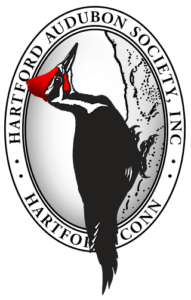Twelve members and friends of the Hartford Audubon Society met in the
Roaring Brook Nature Center parking lot on Sunday, May 1, 2022 for a bird
walk near the start of the songbird migration for neotropical migrants. It was a
gorgeous morning with a light breeze and not a cloud in the bright blue sky.
Unfortunately, for birders, the previous week had seen strong northerly winds,
slowing down the migration and bottling up birds to our south. The migration
would get here, but not on this morning.
Our day began with the “who cooks for you” call of a wild barred owl coming
from the woods. At Roaring Brook Nature Center, one must be certain that
barred owl calls are not emanating from the exhibit birds, Aya and Odin. A
black vulture greeted us from the building roof. Social creatures, black vultures
visit the Center daily to visit Connor, the Center’s resident black vulture, and to
poke at their reflections in the Center’s windows.
Although numerous expected species had not yet arrived, there was no lack of
activity around the building and parking lot. At least five ruby-crowned kinglets
were investigating the soon to open buds of a large crabapple tree, while a crow
attempted to drive off a common raven overhead. Three species of vireo, yellow-
throated, blue-headed and warbling, were calling right behind the parking lot at
the edge of the woods. Early in the season, before the oak buds open, the woods
are relatively quiet, so we made our way to the fields, where the birding is
usually more productive., On the way, we were treated to a hermit thrush,
poking about right on the trail. The fields were eerily devoid of birds. Another
black vulture sat in the old barn’s second story window, and a couple of tree
swallows hawked insects low over the field, but the usually active brushy areas
were devoid of birds. Eventually, we learned the reason why. Perched in a
white pine was a juvenile Cooper’s hawk surveying the scene. Nothing like an
accipiter to quiet things down! After a short time, the hawk departed and birds
began to come out of their hideouts. A pair of eastern bluebirds appeared, and
the sounds of chickadees, titmice and more could be heard around us. Although
warblers were not in abundance, early arrivals made their presence known and
we quickly spotted yellow-rumped, black-and-white, and surprisingly, a palm
warbler, a bird not often seen here in spring. Of the seven warblers sighted on
the walk, the best, seen but for a split second, was a Nashville warbler. Had it
not been for one of our party’s fine photographic skills, this bird would not have
made it onto our list. After a 2.5 mile stroll through a variety of habitats, we
returned to the parking lot. A total of 44 species was seen or heard on the trip.
Respectfully submitted,
Jay Kaplan, Trip Leader

Leave a Reply
You must be logged in to post a comment.